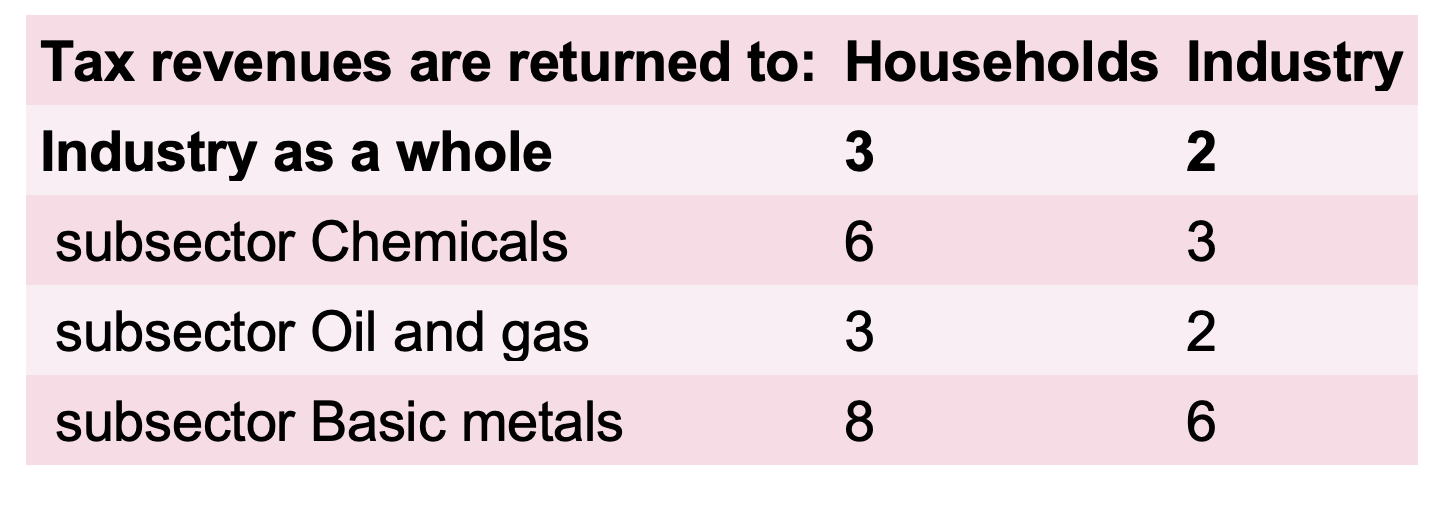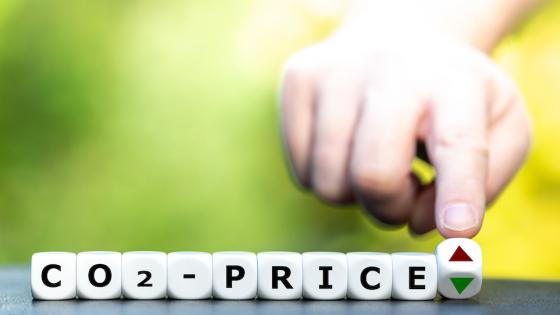Pricing carbon is a cost-effective instrument to achieve emission reduction targets. The introduction of a substantial tax on industrial carbon emissions could be an important part of future climate policy. Tax rate proposals of €100 or €200 per tonne of CO2e in 2030 on top of the carbon price in the EU Emissions Trading System (EU ETS) are not uncommon. However, implementing a national carbon tax has proven to be politically difficult (Stiglitz 2019, Dolphin et al. 2020). A key concern is that such a tax may hurt domestic industrial activity. Another concern is carbon leakage – i.e. the emission reduction achieved domestically could (partly) be offset by an increase in carbon emissions in foreign countries with more favorable tax regimes.
In a recent paper (Bollen et al. 2021), we quantify both effects using the computable general equilibrium (CGE) model WorldScan, which includes global trade effects at a relatively detailed sector level. More specifically, we simulate the impact of four policy scenarios featuring a national carbon tax of €100/tCO2e or €200/tCO2e in 2030, with tax revenues either being returned as a lump sum to households or used as a targeted subsidy for carbon emission reduction in Dutch industry. In the latter case, the additional costs of the carbon tax are partly offset, mitigating the cost price increase and production loss for industrial companies. We assess the robustness of the effects for several model parameters, including trade elasticities, abatement costs, and EU ETS prices.
A cost-effective way to reduce domestic carbon emissions
Table 1 shows the environmental effects of a €100/tCO2e carbon tax.1 Carbon emissions of Dutch industry drop by about 40%. That is, the tax leads industrial emissions to decline from 58 Mt CO2e in 2018 to 21 Mt CO2e in 2030, which is a 40% reduction relative to the no-tax case (36 Mt CO2e). This substantial emission reduction reflects that industrial companies have significant options to reduce emissions against relatively low costs.2 Moreover, the rate of carbon emission reduction increases further if the tax revenues are redirected back to industry in the form of a targeted subsidy for emission reduction. The emission reduction effects are in line with recent empirical results on the EU ETS (Dechezleprêtre et al. 2018).
Table 1 Carbon emission reduction due to a €100/tCO2e carbon tax for Dutch industry, relative to the no-tax case, in 2030 (%)
Notes: * Composition effect from decreasing activity share of the relatively carbon-intensive subsectors within industry. ** Effect from decreasing activity share of industry as a whole.
Production losses for industry are modest
A €100/tCO2e carbon tax has only modest economic effects. The production loss for Dutch industry is 2-3% (see Table 2).3 This result is driven by the fact that energy costs turn out to be only a relatively small part of total input costs and the abatement curve being strongly convex (i.e. a large amount of emissions can be reduced with relatively inexpensive abatement options such as carbon capture and storage). For chemicals and basic metals, the production losses are about twice as large as the rest of industry since these sectors are more carbon-intensive and more sensitive to international competition. Prior empirical studies have also found no or negligible competitiveness effects of carbon pricing (Dechezleprêtre and Sato 2017, Verde 2020).
Table 2 Production loss due to a €100/tCO2e carbon tax for Dutch industry, relative to the no-tax case, in 2030 (%)
Carbon leakage remains a potential concern
Despite the limited production loss for Dutch industry, we find a substantial leakage of carbon emissions to foreign countries (see Table 3). At a carbon tax rate of €100/tCO2e, the leakage ratio indicates that 61% of the emission reduction achieved domestically is offset by an increase in carbon emissions elsewhere. The leakage effect is relatively large because the loss of production is mainly taken over by non-European countries with no binding or relatively mild emission caps, such as China and India. Carbon leakage to these countries can be significant due to differences in the carbon intensity of industrial activities and the additional demand for fossil energy.4 Nevertheless, carbon leakage can be reduced by about a third when tax revenues are used as a targeted subsidy for emission reduction. Sensitivity analyses that include different trade elasticities, abatement costs, and EU ETS prices by and large confirm the pattern of a limited production loss for Dutch industry as well as a substantial carbon leakage to foreign countries. All in all, our results are somewhat larger than recent empirical estimates for the EU ETS (Verde 2020) though close to prior trade-model estimates that consider the effects of substantial carbon price shocks (Branger and Quirion 2014, Carbone and Rivers 2017).
Table 3 Carbon leakage due to a €100/tCO2e carbon tax for Dutch industry, relative to the no-tax case, in 2030
Note: * Defined as (carbon emission increase outside of the Netherlands/carbon emission reduction in the Netherlands) × 100%.
Concluding remarks
The carbon taxes analysed for the Dutch case are substantial (€100 and €200/tCO2e) and our analysis thus contributes to a better understanding of the impact of intensified climate policies around the world. In particular, the tightening of the EU ETS, as envisaged by the European Green Deal, may drive up carbon prices to, for example, €100 per tonne of CO2e. Our study suggests that targeted subsidies for carbon emission reduction may help to lower the leakage ratio in the European case as well. Future work on other anti-leakage measures, such as border tax mechanisms, is needed to enhance the effectiveness of carbon pricing instruments.
References
Bollen, J, D Freeman and R Teulings (2018), “Trade wars: Economic impacts of US tariff increases and retaliations - An international perspective”, CPB background document, 19 November.
Bollen, J, D Freeman and R Teulings (2020), “Trade policy analysis with a gravity model”, CPB background document, 17 July.
Bollen, J, A Deelen, S Hoogendoorn and A Trinks (2021), “CO2-heffing en verplaatsing”, CPB background document (in Dutch), 23 November.
Branger, F, and P Quirion (2014), “Would border carbon adjustments prevent carbon leakage and heavy industry competitiveness losses? Insights from a meta-analysis of recent economic studies”, Ecological Economics 99: 29-39.
Carbone, J C, and N Rivers (2017), “The impacts of unilateral climate policy on competitiveness: evidence from computable general equilibrium models”, Review of Environmental Economics and Policy 11(1): 24-42.
Dechezleprêtre, A, D Nachtigall, and F Venmans (2018), “The joint impact of the European Union emissions trading system on carbon emissions and economic performance”, OECD working paper.
Dechezleprêtre, A, and M Sato (2017), “The impacts of environmental regulations on competitiveness”, Review of Environmental Economics and Policy 11(2): 183-206.
Dolphin, G, M G Pollitt, and D M Newbery (2020), “The political economy of carbon pricing: a panel analysis”, Oxford Economic Papers 72(2): 472-500.
Stiglitz, J E (2019), “Addressing climate change through price and non-price interventions”, European Economic Review 119: 594-612.
Verde, S F (2020), “The impact of the EU emissions trading system on competitiveness and carbon leakage: the econometric evidence”, Journal of Economic Surveys 34(2): 320-343.
Endnotes
1 The economic and environmental effects of a €200/tCO2e carbon tax are included in Bollen et al. (2020).
2 We verified the potential and costs of these carbon emission reduction techniques by conducting a review of the most recent literature on emission abatement technologies in Dutch industry.
3 Since industrial companies cannot fully pass on the extra costs of the carbon tax to their customers, the market price for industry as a whole increases by 0.4%. As a consequence, Dutch industry loses market share in world production, represented by a decline of exports (-2.4%). The degree to which exports react to a price change depends on the price substitution elasticity – the Armington elasticity – which, according to recent empirical estimates, is about 6 for industry as a whole (Bollen et al. 2018, 2020). The decline of exports (i.e., production loss) therefore equals 6 (Armington elasticity) times 0.4 (market price increase).
4 A carbon tax for Dutch industry will reduce the export of carbon intensive products to other European countries. Subsequently, these countries have to increase their own industrial production and lower their exports to meet domestic demand. In response, non-European countries such as China and India also increase their industrial production to maintain consumption levels. However, China and India so far do not have binding emission caps and the carbon intensity of industrial activities is on average 2.5 times higher than in Europe. Moreover, the additional production of industrial products will be accompanied by a greater demand for electricity that is often generated through the use of fossil energy. As a consequence, carbon emissions in non-European countries such as China and India can be five times higher than in Europe. Finally, the additional production in these countries also generates GDP growth, which leads to extra traffic (often based on fossil fuels) and demand for services.









